Interview: Panoramical’s Fernando Ramallo and David Kanaga
Turn on, tune In, zone out: a conversation with the men behind a new "interactive anthology of musical landscapes."
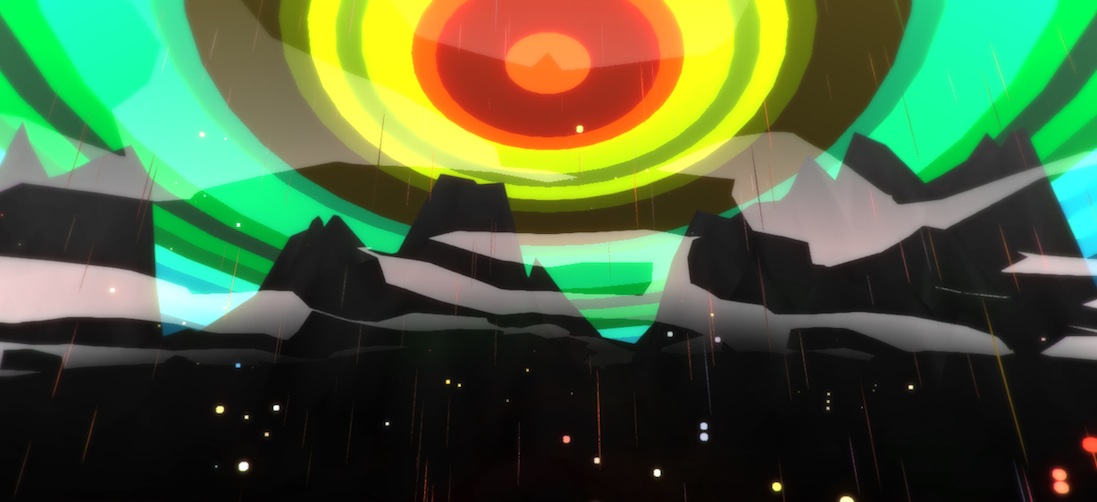
Interview: Panoramical’s Fernando Ramallo and David Kanaga
Turn on, tune In, zone out: a conversation with the men behind a new "interactive anthology of musical landscapes."

The question of how we fuzzy-eared meat sacks might best experience electronic music has certainly been asked before, with technologies and platforms ranging from cassette tapes to Peter Gabriel–produced CD-ROMs. Now, the question is being asked once again by Fernando Ramallo and David Kanaga, with their just-released not-quite-a-game, Panoramical.
The developers describe Panoramical as “an interactive anthology of musical landscapes that morph to your touch.” Instead of controlling an avatar, the user employs a game controller, MIDI controller, or mouse-and-keyboard combo to shape both the world and the music together, as if they are part of one cohesive entity. The two are fluid and hyper-connected, with audio and visual fabric sewn into one another with bits of code—and the result is a meditative, extraordinary way of absorbing music. The experience is dramatically more sophisticated than the kinds of WebGL and iPad experiments we’ve seen before it, with controls that feel taut and physical in ways that reference both games and music production.
Ramillo designed and coded the game’s visuals, integrating the musical contributions of Kanaga, who has released records on Daniel Lopatin’s Software Recording Co., and provided the interactive score for 2013’s exploratory game, Proteus. Guest musicians included former Anticon member Doseone and Japanese producer Baiyon, among others.
In its populist form, Panoramical is available now for $10 on PC and Mac. For $100, those looking to use the game as a creative tool get permission to showcase Panoramical in public, the ability to feed the visuals into other software using the popular Syphon codec, an automatic play mode that keeps things moving on their own, all future DLC and updates, and a direct support line to the developers. There’s also a limited-run, wood-cased MIDI controller, designed specifically for the game.
Regardless of one choice of interaction method (MIDI controllers, game controllers, and mouse/keyboard combos all work surprisingly well), Panoramical is a transcendent experience, and one that peers into the future in new and exciting ways. We spoke to Ramallo and Kanaga about their work on the project, which has spanned the last three years.
Were there any particular themes, musically, programmatically, or conceptually, that you guys specifically wanted to explore with Panoramical?
Fernando Ramillo: Development of Panoramical was very freeform—we didn’t have any guidelines or goals as we were making it, [and] we kept what worked as we went along. I knew from the start that I didn’t want to add any traditional gameplay elements to it, and tried to explore the pure interaction as much as possible.
Based on that, it was pretty much about trying stuff out. Anything. Purely abstract scenes, representational ones, fast-paced, slow, bright, dark, anything. Visually, it’s trying to be as diverse and interesting as possible. By the end of development, when we put everything together, some themes popped up by themselves. As I was making the transitions, I explored a very loose thematic arc about multiple dimensions, infinite spaces, the player exploring all these spaces that exist at once, where manipulating the controls changes the slice you’re looking at. The selection screen and ending have some elements of this, zooming out into infinity revealing you were only looking at a tiny slice of an infinite universe.
David Kanaga: For me, it was really cool how Panoramical embodied hyper-condensed versions of ideas and music-game forms I’d worked with previously. The form of music-textural changes tied to landscape, from Proteus, or speed/intensity, from Dyad, were used compositionally in much the same way—but with greatly amplified immediacy, now touching the sound variables directly. Playing Panoramical is very much like touching the various dimensions of the audio engines of those games directly, as opposed to indirectly, via gamespace. The “higher dimensions” theme felt huge to me, the fact that even dimensions greater than four (which is often thought as already quite otherwordly) can be felt in a very intuitive way when the “space” concerned isn’t our kind of physical floor/walls/sky space, but is a possibility space, where all the dimensions are “freedoms” instead of right angles. I’d been acquainted with the idea of “degrees of freedom” before, but this really allowed me to internalize that, understand a microcosmic picture of the idea with really solid concreteness.
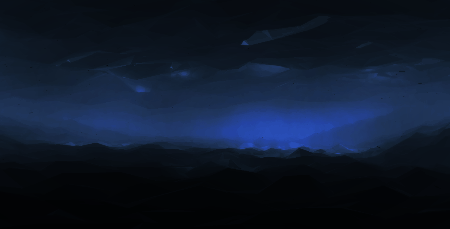
Like Fernando says, themes popped up—what’s even more interesting to me than what we set out to explore is the space that opened up through the process of making it. There are so many loose themes floating around. At some point I began to associate all of the movement and freedom and control with more concrete Earth topics, like geoengineering and terraforming, which was a little more freaky than the math-y grandeur of metaphysical freedoms, dimensions, etc. A theme that felt implied is that “you can always change the environment” or “change the weather” to your liking….and that’s a little troubling to me, if read in the context of our earth-home, because it’s clearly not the case. Somehow that thematic profile snuck into how I was thinking about things, and the game definitely doesn’t propose any resolution to all of it. But I think some of the more anxious-sounding levels, and finally the whole warp, which feels to me quite dark, was informed by some of these associative relations between game environment and earth environment. It’s kind of a horror game, in its own way…I call it an ecological game, since it’s just raw materials, as opposed to economic strategy-functions) Ecology of Fear comes to mind—haven’t read that, but may do so now.
How did you guys end up coming together to work on Panoramical?
Ramallo: David and I met at a games festival in LA a few years back, and stayed in touch ever since. I was surprised to hear David had played a very tiny game I made for an experimental contest, and we had similar ideas on the type of work we wanted to do. We made a few prototypes together once playing around using the nanoKONTROL MIDI controller as an interface, and things carried on from there.
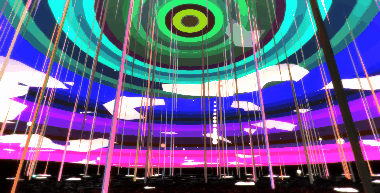
Now that the game is out, what have you been surprised by in terms of users’ responses to it?
Ramallo: It’s been great to see players use the built-in Twitter functionality to share their “discoveries”. This was actually a very, very late addition, right as the game was pretty much done, so I’m glad it’s being used. What I was most excited about was people making their own interfaces to play the game with, like someone projecting the Pro version on a shipping container, or Anthony Carboni making his own touch interface.
How long would it generally take to integrate a song, be it one of David’s or an external producer? Do you plan to release more songs, or do you plan to keep it as as-is, as a self-contained album of sorts?
Ramallo: It really depended on the scene and the state of the project. As we created generic tools to make it easier to experiment, it became easier to get scenes going. There was a lot, a lot of experimentation involved and creating and scrapping things to get a scene to a complete state. They’d generally take two or three weeks to fill up all the parameters, and one or two weeks to polish. Some required specific things to be coded for, so they took more time. I think the one that took the longest was Mr. Div and Baiyon’s, because by the time we started, we didn’t have the generic tools in place and everything was coded from scratch—plus it had to have super precise, beat-driven animations, and every element was completely different. I’m proud of it though—it looks and feels amazing. We’d love to release more scenes if the game does well.
What exactly is happening when the players moves the XY sliders? It seems like you’re mixing in tracks along each axis, as well as applying certain effects chains? How did you figure out a framework to keep these interactions feeling consistent, but not too consistent?
Ramallo: There are plenty of things happening at once as you move each slider. I created some tools where you can basically bind any property in any object to a specific slider. So the changes are parameters being modified in the objects of the scene and the audio loops at the same time. For example, we would bind the speed of the scene and the pitch of a looping sample to this one slider, so when you change it, it feels like the sound is tightly bound to the scene’s speed. It’s layers and layers of little interactions like that.
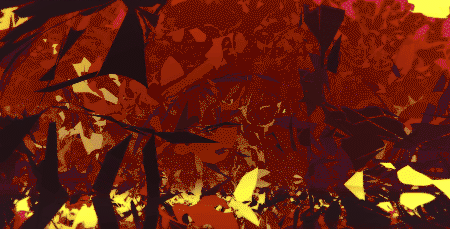
Usually I would add the interactions on the visuals, and David would then author sounds and effects and bind them to the same sliders, aside from a few exceptions where I made visuals based on the sound interactions that he had made. So the visuals aren’t reacting to the audio or vice versa, per se, but we found our way worked even better than straight visualization techniques which can be predictable and noisy. Authoring either content to match those relationships specifically worked really well.
Kanaga: Sometimes parameters are changed smoothly with the player’s movement along axes, as with a filter opening up and closing, or the wet/dry mix of a delay. Sometimes, an array of discrete events are triggered—pop pop pop—it feels a little like scraping a guiro. One of the most interesting things for me about working with Fernando’s visuals—as opposed to, for instance, mapping a MIDI setup in Ableton—is that the visual intensities are not linear; sometimes an intensity like brightness maxes out at a slider’s 75-percent value, and then dips back down. This suggests that an appropriate way to score that brightness musically involves, for instance, opening a filter all the way at 75 percent and then closing back up as it reaches 100 percent. It’s simple, but the irregularity is very satisfying. There are loads of little strange asymmetries in the game like this.
As for consistency, that was mostly just feeling out synesthetic resonances between visual and potential aural intensities, and mirroring them to some degree.
“Just a day or two after launch, someone made their own touch interface and projected it on a 53-foot shipping container!”
What are some of the coolest things you’ve seen people do with the Pro license thus far?
Ramallo: Just a day or two after launch, someone made their own touch interface and projected it on a 53-foot shipping container! Also, someone else put it on auto-play and streamed it for 50 hours straight. I’m looking forward to more people using it and sending feedback so I can keep adding features to turn it into a really cool tool.
What’s your preferred way of controlling the game? I was surprised at how clean and responsive the game feels with a standard dual analog controller.
Kanaga: Now my favorite way to play is keyboard and mouse, though I used to only like playing it with MIDI controls. My preference changed after we regrouped the trigger keys; it used to be the bottom row (from “z” to “.”), instead of the three-by-three grid that it is now. The grid is easier to mentally map for me than a long skinny MIDI row, and also easier to mash buttons, which I love, holding down a bunch at once.
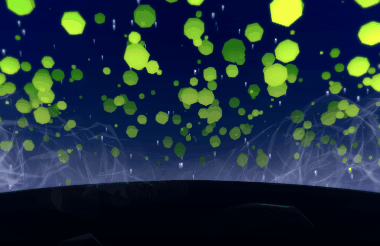
David, do you plan to play live shows using Panoramical or a a similar setup? It’s surprisingly performative.
Kanaga: I may do future live shows using similar processes, but likely not with the game proper. I would hope that the definitive “performance” of the game is the first-person experience of playing it at home.
That said, I did do one accidental “accompaniment” performance to Panoramical last year at Incubate festival in the Netherlands. I had been playing keyboard accompaniments to Wolfenstein and Diablo and Infinite Doodle, live-scoring them, and my set was going to close by letting the audience play a scene from Panoramical while I sat back. But a performance demon showed up, and bizarrely cut out all of the sound in the scene except for a bassline triggered in the discrete-guiro style (described above). It was kind of haunting. So I hopped back onto the keyboard, and played harmonies along with the bassline, which was being played by the audience member (performer). So, that was really serendipitous, better than I’d have thought up on my own, and an unexpectedly intimate improvisation. Something like that could be a fun situation to repeat intentionally.
The limited-edition MIDI controller looks incredible—how did that release come about?
Ramallo: Brendan Byrne, a friend from Brooklyn, made a custom controller for us after playing it at a festival, which we ended up using to showcase the game at several other events. He’s insanely good at making all these beautiful polished wooden custom controllers, so we knew we wanted to try and make a bunch of them for sale. He ended up making 50 of them, all assembled in his own apartment. The fact that we could have these beautiful physical artifacts designed for Panoramical still blows my mind. He’s awesome and you should buy his stuff.

